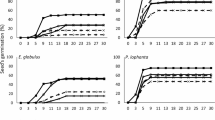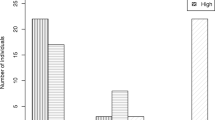Abstract
The Novel Weapons Hypothesis predicts that invasive plants excel in their new ranges because they produce novel metabolites to which native species possess little resistance. We examined the novelty of the phytochemistry of the Eurasian invader, Alliaria petiolata, in North America by comparing its phytochemical profile with those of closely related Brassicaceae native to North America. We examined the profile and/or concentrations of glucosinolates, alliarinoside, flavonoids, cyanide, and trypsin inhibitors in cauline leaves of field-collected A. petiolata, Arabis laevigata, Cardamine concatenata, C. bulbosa, and C. douglassii. Cyanide and the glucosinolates and flavonoids produced by A. petiolata were detected only in A. petiolata. Trypsin inhibitor activity was highest in A. laevigata, intermediate in the Cardamine species, and lowest in A. petiolata. The phytochemical profile of A. petiolata was distinct from those of four closely related and/or abundant Brassicaceaeous species native to North America, providing support for the Novel Weapons Hypothesis.


Similar content being viewed by others
References
Al-Shehbaz IA, Beilstein MA, Kellogg EA (2006) Systematics and phylogeny of the Brassicaceae (Cruciferae): an overview. Plant Syst Evol 259:89–120
Barto EK, Cipollini D (2009) Garlic mustard (Alliaria petiolata) removal method affects native establishment. Invasive Plant Sci Manag 2:230–236
Callaway RM, Aschehoug ET (2000) Invasive plants versus their new and old neighbors: a mechanism for exotic invasion. Science 290:521–523
Callaway RM, Ridenour WM (2004) Novel weapons: invasive success and the evolution of increased competitive ability. Front Ecol Environ 2:436–443
Callaway RM, Cipollini D, Barto K, Thelen GC, Hallett SG, Prati D, Stinson K, Klironomos J (2008) Novel weapons: invasive plant suppresses fungal mutualists in America but not in its native Europe. Ecology 89:1043–1055
Cappuccino N, Arnason JT (2006) Novel chemistry of invasive exotic plants. Biol Lett 2:189–193
Carpenter D, Cappuccino N (2005) Herbivory, time since introduction and the invasiveness of exotic plants. J Ecol 93:315–321
Cipollini DF (2002) Variation in the expression of chemical defenses in Alliaria petiolata (Brassicaceae) in the field and common garden. Am J Bot 89:1422–1430
Cipollini DF, Bergelson J (2001) Plant density and nutrient availability constrain constitutive and wound-induced expression of trypsin inhibitors in Brassica napus. J Chem Ecol 27:593–561
Cipollini DF, Gruner B (2007) Cyanide in the chemical arsenal of garlic mustard, Alliaria petiolata. J Chem Ecol 33:85–94
Cipollini DF, Mbagwu J, Barto K, Hillstrom C, Enright S (2005) Expression of constitutive and inducible chemical defenses in native and invasive populations of Alliaria petiolata. J Chem Ecol 31:1255–1267
Dolédec S, Chessel D (1987) Rythmes saisonniers et composantes stationnelles en milieu aquatique I—Description d’un plan d’observations complet par projection de variables. Acta Oecologica, Oecolgia Generalis 8:403–426
Dray S, Dufour AB (2007) The ade4 package: implementing the duality diagram for ecologists. J Stat Softw 22:1–20
Evans JA, Landis DA (2007) Pre-release monitoring of Alliaria petiolata (garlic mustard) invasions and the impoacts of extant natural enemies in southern Michigan forests. Biol Control 42:300–307
Fahey JW, Zalcmann AT, Talalay P (2001) The chemical diversity and distribution of glucosinolates and isothiocyanates among plants. Phytochemistry 56:5–51
Feeny P, Rosenberry L (1982) Seasonal variation in the glucosinolate content of North American Brassica nigra and Dentaria species. Biochem Syst Ecol 10:23–32
Gols R, Raaijmakers CE, van Dam NM, Dicke M, Bukovinszky T, Harvey JA (2007) Temporal changes affect plant chemistry and tritrophic interactions. Basic Appl Ecol 8:421–433
Haribal M, Renwick JAA (1998) Isovitexin 6′′-O-β-D-glucopyranoside: a feeding deterrent to Pieris napi oleracea from Alliaria petiolata. Phytochemistry 47:1237–1240
Haribal M, Renwick JAA (2001) Seasonal and population variation in flavonoid and alliarinoside content of Alliaria petiolata. J Chem Ecol 27:1585–1594
Haribal M, Renwick JAA, Attygalle AB (1999) A new sinapoyl derivative of isovitexin 6”-O-β-D-glucopyranoside from Alliaria petiolata. J Nat Prod 62:179–180
Haribal M, Yang Z, Attygalle AB, Renwick JAA, Meinwald J (2001) A cyanoallyl glucoside from Alliaria petiolata, as a feeding deterrent for larvae of Pieris napi oleracea. J Nat Prod 64:440–443
Hicks KL, Tahvanainen JO (1974) Niche differentiation by crucifer-feeding flea beetles (Coleoptera: Chrysomelidae). Am Midl Nat 91:406–423
Inderjit SeastedtTR, Callaway RM, Pollock JL, Kaur J (2008) Allelopathy and plant invasions: traditional, congeneric, and bio-geographical approaches. Biol Invasions 10:875–890
Keeler MS, Chew FS (2008) Escaping an evolutionary trap: preference and performance of a native insect on an exotic invasive host. Oecologia 156:559–568
Koch MA, Haubold B, Mitchell-Olds T (2000) Comparative evolutionary analysis of chalcone synthase and alcohol dehydrogenase loci in Arabidopsis, Arabis, and related genera (Brassicaceae). Mol Biol Evol 17:1483–1498
Lankau RA, Nuzzo V, Spyreas G, Davis AS (2009) Evolutionary limits ameliorate the negative impact of an invasive plant. Proc Natl Acad Sci USA 0.1073/pnas.0905446106
Lewis KC, Bazzaz FA, Liao Q, Orians CM (2006) Geographic patterns of herbivory and resource allocation to defense, growth, and reproduction in an invasive biennial, Alliaria petiolata. Oecologia 148:384
Mallik AU, Pellissier F (2000) Effects of Vaccinium myrtillus on sprice regeneration: tesing the notion of coevolutionary significant of allelopathy. J Chem Ecol 26:2197–2209
McKenney JL, Cripps MG, Price WJ, Hinz H, Schwarzländer M (2007) No difference in competitive ability between invasive North American and native European Lepidium draba populations. Plant Ecol 193:293–303
Nuzzo V (2002) Element stewardship abstract for Alliaria petiolata (Alliaria officinalis) garlic mustard. Nature Conservancy, Arlington, Virginia, USA, p 19
Prati D, Bossdorf O (2004) Allelopathic inhibition of germination by Alliaria petiolata (Brassicaceae). Am J Bot 91:285–288
R Development Core Team (2008) R: a language and environment for statistical computing. R Foundation for Statistical Computing, Vienna
Renwick JAA (2002) The chemical world of crucivores: lures, treats and traps. Entomol Exp Appl 104:35–42
Renwick JAA, Zhang W, Haribal M, Attygalle AB, Lopez KD (2001) Dual chemical barriers protect a plant against different larval stages of an insect. J Chem Ecol 27:1575–1583
Roberts KJ, Anderson RC (2001) Effect of garlic mustard [Alliaria petiolata (Bieb. Cavara & Grande)] extracts on plants and arbuscular mycorrhizal (AM) fungi. Am Midl Nat 146:146–152
Stinson KA, Campbell SA, Powell JR, Wolfe BE, Callaway RM, Thelen GC, Hallett SG, Prati D, Klironomos JN (2006) Invasive plant suppresses the growth of native tree seedlings by disrupting belowground mutualisms. PLoS Biol 4:0727–0731
Vaughn SF, Berhow MA (1999) Allelochemicals isolated from tissues of the invasive weed garlic mustard (Alliaria petiolata). J Chem Ecol 25:2495–2504
Wolfe BE, Rodgers VL, Stinson KA, Pringle A (2008) The invasive plant Alliaria petiolata (garlic mustard) inhibits ectomycorrhizal fungi in its introduced range. J Ecol 96:777–783
Acknowledgments
We would like to thank Steph Enright and Hetal Rawal for help collecting and processing samples. Funding was provided by an Environmental Protection Agency Greater Research Opportunities Fellowship to E.K. Barto (#91673701), the Ohio Board of Regents, and Wright State University.
Author information
Authors and Affiliations
Corresponding author
Rights and permissions
About this article
Cite this article
Barto, E.K., Powell, J.R. & Cipollini, D. How novel are the chemical weapons of garlic mustard in North American forest understories?. Biol Invasions 12, 3465–3471 (2010). https://doi.org/10.1007/s10530-010-9744-5
Received:
Accepted:
Published:
Issue Date:
DOI: https://doi.org/10.1007/s10530-010-9744-5




